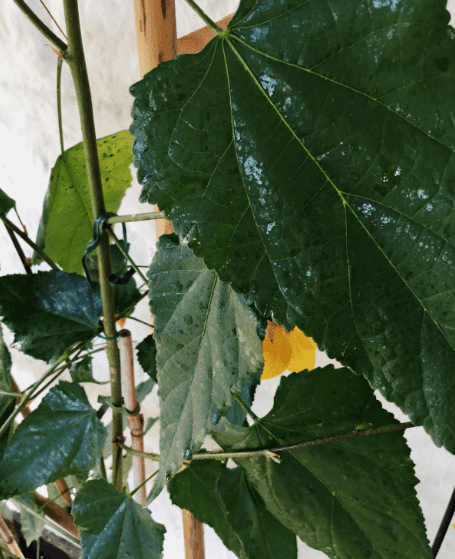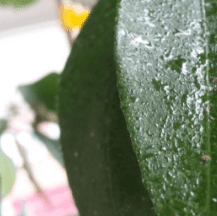Sticky plant leaves can be an ugly but typical houseplant phenomenon. The causes could be organic or the result of unwelcome pests excreting on your plants.

The sticky substance on plant leaves can either be produced naturally by plants or as a result of pests like aphids and scales excreting their waste on the leaves. While pests sip nectar from plants and create honeydew, which also leaves a sticky residue on plant leaves, plants secrete nectar for defense and to attract food.
Knowing where the sticky sap is coming from will help you solve this sticky predicament. Knowing where it came from will help you understand the situation better. Both bugs and plants themselves can produce sticky sap.
If you look more closely, you can see if the problem is with your plant specifically or if there is a larger pest invasion at play. We’ll talk about them both and how to get rid of these sticky plants.
For a wonderful price, I purchase happiness pure neem oil from Amazon. It produces brilliant leaves and offers a layer of defense for plants against known pests. It works great. Clicking here will take you there!
Table of Contents
What Can Cause Sticky Substances on Plants?
1. Secretion from Insects (Honeydew)
The typical culprits for sticky secretions on plant leaves are insects like mealybugs, aphids, and scale.
By sucking sap from the plant’s phloem, these sap-sucking insects consume the nectar of the plants.
Sugars and other metabolic products are transported to other areas of vascular plants by the living tissue known as phloem (source).
By sucking food directly from the leaves, these insects rob the plant of the food it produces in the leaves and transfer it to other areas of the plant.
After the insects have digested the sugars from the plants, they generate honeydew, which is faeces.
The honeydew sticks to the plants and occasionally drips onto the lower leaves, luring ants and other unwelcome insects to the plant.
On the surface of leaves, mold and other fungus can grow and in some cases completely cover them as a result of insects drawn to honeydew. As soon as you see the leaves are sticky, you should clean them off.
In this instance, the pest is the main issue, so it needs to be dealt with right away.
With these affordable microfiber cloths from Amazon, cleaning plant leaves has never been simpler.
2. Secretions from Plant Nectaries –
Sticky nectars are produced by plants to either attract or occasionally repel specific insects.
Using nectar secretions to protect plants
Extrafloral nectaries are secretory organs that exist in plants. These glands are present throughout the non-flowering portions of thousands of plants.
The purpose of these nectaries is to create nectars that will draw ants, who will shield the plant from herbivores. The sticky substance creates a symbiotic relationship where the plant needs it to survive in the wild.
When plants produce sap to fend off insects, it serves as a survival strategy.
In order to defend itself, the plant releases nectar that is repulsive to the invader insects when they come too close, and as a result, the insects flee.
Secretions of Nectar for Plant Reproduction –
When nectar is released in floral nectaries (nectar at the flowering portions) to draw insects like bees and butterflies, this practice is known as entomophily and is done to ensure that the insects can help to carry on the plant species through pollination.
Food Attraction via Nectar Secretions –
When it comes to plants like sundews or other carnivorous plants, the attraction may not be that great for insects.
To draw insects for food and survival is the goal. Secretions are produced and may stay on the stem, oxidizing it and giving it a brownish color. Insects that come to drink the nectar are grabbed by the plants, who then eat them.
3. Bacterial Infections
The sticky substance that is often observed on plant leaves can occasionally be the source of a bacterial or fungal illness.
Infected leaves with wounds or broken pieces exposed to the open air are frequently the source of bacterial illnesses.
Plants that are specifically susceptible to bacterial diseases include:
- Viper Plants
- Delicious Monstera
Erwinia infection is a typical bacterial infection type.
A quick rotting of the tuber, which emits a foul odor, and drooping of the leaves are signs of its start.
The bacterium exists in most soils, but it is encouraged by excessive warmth, fertilizer use, and use of a thick growing media that results in excessive humidity.
Erwinia infections are frequently treated incorrectly because they are misdiagnosed as fungal infections. The best course of action in this situation is to amputate the damaged areas since there is no known chemical or pharmaceutical treatment for the condition.
Now, if nothing is done after the cut is made, chopping off the concerned area could also result in further exposure.
Cinnamon applied directly to the damaged area works best as an antifungal remedy for a severed leaf or stem. The same results are obtained when plants with open wounds are treated with cinnamon oil.
How to Prevent Bacterial Infections in Plants
- Make sure your plants are strong and healthy by providing them with plenty of light and ventilation and removing any questionable or sick plants.
- Avoid abrupt pH changes.
- Avoid using misting spray to lower the temperature and avoid inconsistent watering (over-watering, drought)
- Avoid soil with a pH of less than 5.5. Avoid using growing mediums that are too peaty (make sure the soil is well-aerated), have an excessive amount of nitrogen, or apply a lot of fertilizer at once.
- Use alcohol or diluted bleach to clean any used equipment and materials.
- Avoid temperatures that are either too high (above 25°C – 77°F) or too low (below 10°C – 50°F) and excessive humidity.
- Reusing diseased plants’ compost or earthenware containers is not advised because disinfection is difficult to achieve.
- When repotting the tuber, avoid covering it with compost.
- Beware of contaminated drainage water that could spread disease from one pot to another (take care with sub-irrigation and gutter irrigation)

Why does the Nectar and Honeydew Look Brown and Sticky?
When the nectar is finished being created, it can fall to the ground or to other leaves nearby.
If you detect the sticky nectar right away, it might not be a good idea to leave it because they might draw more insects.
The sticky substance may also lead to the accumulation of dust and other germs, making the area even less appealing to look at.
The oxidation of the nectar’s organic sugars, as explained above, is what gives the liquid its brown colour. In addition, fungus may grow and accumulate on honeydew, giving it a shady appearance.
Unwanted Attraction of Insects-
Secretions such as nectar or others could draw opportunistic guests into your house. The plants in the wild behave in this manner by nature. Do not begin to destroy the vegetation!
As a plant owner, you might not want ants, lizards, and other small insects entering your home because they will not only search for nectar but also for other items that appear to be tasty.
This is why you should remove any sugary stickiness from the floor or plant leaves before the invasion starts.
How to Control Scale and Other Sap Producing Insects?
Aphids, Mealybugs, and scale are some of the insects that produce honeydew more frequently.
The level of these insects’ infestation on the plants may influence the technique of control.
When using these insects’ control tactics within the home, caution must be exercised.
It is never advised to use chemical insecticides in the home because they could harm you or anybody else sharing the area in addition to killing pests.
1. Scale –
Insects covered in a protective brown shell-like scale that is tiny, oval, and flat.
Given because pesticides cannot penetrate their protective shell-like layer, they might be challenging to manage.
The scale can be physically removed off the plant by wiping it off with a cloth dipped in warm water, or it can be soaked off with a cotton swab dipped in rubbing alcohol.
After reading this post, perhaps you won’t have to wait until your indoor plants are too far gone and plagued with scale before taking action to get rid of these parasites.
2. Aphids –
– Scales. Of the two types of scales, armored and soft-bodied, only soft-bodied scales produce honeydew. … Use alcohol or weak bleach to clean the used materials and instruments.
Avoid temperatures that are too warm or too low (below 10°C or 50°F), as well as severe humidity.
Due to the difficulty of disinfection, neither the compost nor the clay pots used by infected plants should be reused.
At repotting time, avoid covering the tuber with compost.
Be cautious of contaminated drainage water that can transfer infection from one pot to another (take care with sub-irrigation and gutter irrigation)
Following production, the nectar may fall to the ground or to leaves below it.
3. Mealybugs –
If you discover the sticky nectar right away, you should probably avoid leaving it because it will likely draw more insects.
In addition to making it stickier, the sticky substance may also trap and collect dust and other diseases, making the area even less appealing to look at.
As previously indicated, the organic sugars in the nectar have oxidized, giving the nectar its brownish hue. Honeydew can also lead to fungus colonization and growth, which darkens the honeydew and gives it a slimy appearance.
Other secretions, such as nectar, could draw opportunistic guests into your house. In the wild, plants behave naturally in this way. Stop destroying the vegetation right now!
How to Clean Sticky Plant Leaves
As a plant owner, you might not want ants, lizards, and other small insects entering your house since they’ll go for more than just the nectar; they’ll also likely be looking for other foods that seem edible.
- Thus, before the invasion starts, you should remove the sweet stickiness off the ground or the plant’s leaves.
- Aphids, Mealybugs, and scale are a few of the more widespread insects that create honeydew.
- Depending on how badly these insects have infested the plants, a particular control approach may be necessary.
When employing ways to eradicate these insects within the home, caution must be exercised.
Chemical insecticides should never be used inside the house since they could harm you or anybody else who lives there in addition to the bugs they are intended to kill.
Insects are covered in a small, flat, oval-shaped scale that is protectively shaped like a brown shell.
FAQ
How do you get rid of sticky residue on plants?
A cotton swab soaked in rubbing alcohol can be used to wet the scales before physically cleaning them off the plant using a cloth dampened with warm water.
What insect leaves a sticky residue?
After reading this post, perhaps you won’t have to get to the point when you need to remove house plants because they are too far gone and infested with scale.
Why are my plants so sticky?
Infestation of scales, tiny insects that hook onto your plant and suck out its moisture, excrete it as this sticky fluid known as “honeydew,” is most likely the cause of your indoor plants’ sticky leaves.
